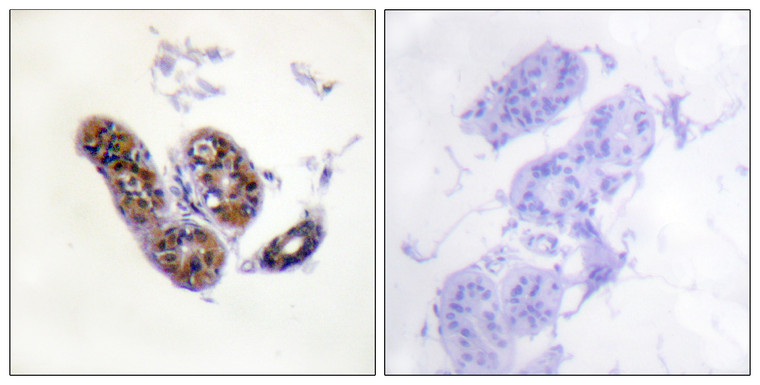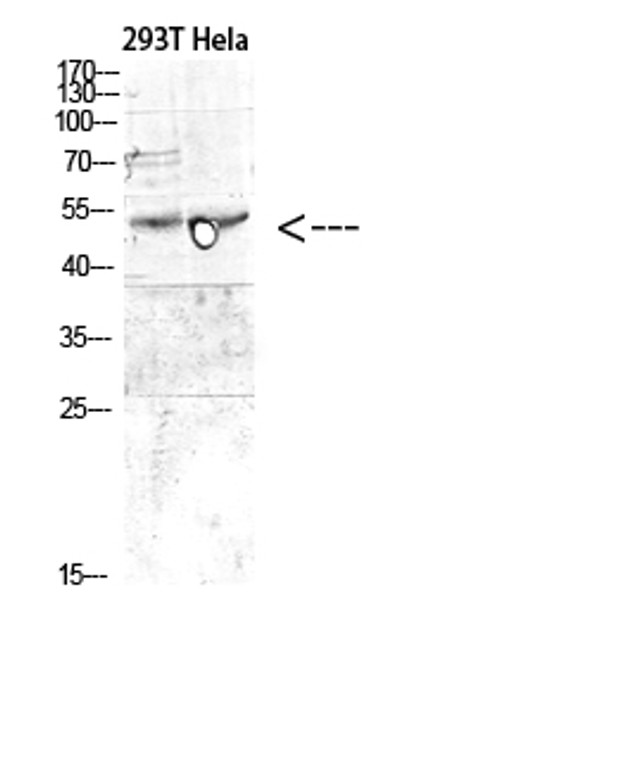| Host: |
Rabbit |
| Applications: |
WB/IHC/IF/ELISA |
| Reactivity: |
Human/Mouse |
| Note: |
STRICTLY FOR FURTHER SCIENTIFIC RESEARCH USE ONLY (RUO). MUST NOT TO BE USED IN DIAGNOSTIC OR THERAPEUTIC APPLICATIONS. |
| Short Description: |
Rabbit polyclonal antibody anti-Microphthalmia-associated transcription factor (151-200) is suitable for use in Western Blot, Immunohistochemistry, Immunofluorescence and ELISA research applications. |
| Clonality: |
Polyclonal |
| Conjugation: |
Unconjugated |
| Isotype: |
IgG |
| Formulation: |
Liquid in PBS containing 50% Glycerol, 0.5% BSA and 0.02% Sodium Azide. |
| Purification: |
The antibody was affinity-purified from rabbit antiserum by affinity-chromatography using epitope-specific immunogen. |
| Concentration: |
1 mg/mL |
| Dilution Range: |
WB 1:500-1:2000IHC 1:100-1:300IF 1:200-1:1000ELISA 1:10000 |
| Storage Instruction: |
Store at-20°C for up to 1 year from the date of receipt, and avoid repeat freeze-thaw cycles. |
| Gene Symbol: |
MITF |
| Gene ID: |
4286 |
| Uniprot ID: |
MITF_HUMAN |
| Immunogen Region: |
151-200 |
| Specificity: |
MITF Polyclonal Antibody detects endogenous levels of MITF protein. |
| Immunogen: |
The antiserum was produced against synthesized peptide derived from human MITF. AA range:151-200 |
| Tissue Specificity | Expressed in melanocytes (at protein level). Isoform A2: Expressed in the retinal pigment epithelium, brain, and placenta. Expressed in the kidney. Isoform C2: Expressed in the kidney and retinal pigment epithelium. Isoform H1: Expressed in the kidney. Isoform H2: Expressed in the kidney. Isoform M1: Expressed in melanocytes. Isoform Mdel: Expressed in melanocytes. |
| Post Translational Modifications | When nutrients are present, phosphorylation by MTOR at Ser-5 via non-canonical mTORC1 pathway promotes ubiquitination by the SCF(BTRC) complex, followed by degradation. Phosphorylation at Ser-405 significantly enhances the ability to bind the tyrosinase promoter. Phosphorylation by MARK3/cTAK1 at Ser-280 promotes association with 14-3-3/YWHA adapters and retention in the cytosol. Phosphorylated at Ser-180 and Ser-516 following KIT signaling, triggering a short live activation: Phosphorylation at Ser-180 and Ser-516 by MAPK and RPS6KA1, respectively, activate the transcription factor activity but also promote ubiquitination and subsequent degradation by the proteasome. Phosphorylated in response to blue light (415nm). Ubiquitinated by the SCF(BTRC) and SCF(FBXW11) complexes following phosphorylation ar Ser-5 by MTOR, leading to its degradation by the proteasome. Ubiquitinated following phosphorylation at Ser-180, leading to subsequent degradation by the proteasome. Deubiquitinated by USP13, preventing its degradation. |
| Function | Transcription factor that acts as a master regulator of melanocyte survival and differentiation as well as melanosome biogenesis. Binds to M-boxes (5'-TCATGTG-3') and symmetrical DNA sequences (E-boxes) (5'-CACGTG-3') found in the promoter of pigmentation genes, such as tyrosinase (TYR). Involved in the cellular response to amino acid availability by acting downstream of MTOR: in the presence of nutrients, MITF phosphorylation by MTOR promotes its inactivation. Upon starvation or lysosomal stress, inhibition of MTOR induces MITF dephosphorylation, resulting in transcription factor activity. Plays an important role in melanocyte development by regulating the expression of tyrosinase (TYR) and tyrosinase-related protein 1 (TYRP1). Plays a critical role in the differentiation of various cell types, such as neural crest-derived melanocytes, mast cells, osteoclasts and optic cup-derived retinal pigment epithelium. |
| Protein Name | Microphthalmia-Associated Transcription FactorClass E Basic Helix-Loop-Helix Protein 32Bhlhe32 |
| Database Links | Reactome: R-HSA-3232118 |
| Cellular Localisation | NucleusCytoplasmLysosome MembraneWhen Nutrients Are PresentRecruited To The Lysosomal Membrane Via Association With Gdp-Bound Ragc/Rragc (Or Ragd/Rragd): It Is Then Phosphorylated By MtorPhosphorylation By Mtor Promotes Ubiquitination And DegradationConverselyInhibition Of Mtorc1Starvation And Lysosomal DisruptionPromotes Dephosphorylation And Translocation To The NucleusPhosphorylation By Mark3/Ctak1 Promotes Association With 14-3-3/Ywha Adapters And Retention In The Cytosol |
| Alternative Antibody Names | Anti-Microphthalmia-Associated Transcription Factor antibodyAnti-Class E Basic Helix-Loop-Helix Protein 32 antibodyAnti-Bhlhe32 antibodyAnti-MITF antibodyAnti-BHLHE32 antibody |
Information sourced from Uniprot.org
12 months for antibodies. 6 months for ELISA Kits. Please see website T&Cs for further guidance














